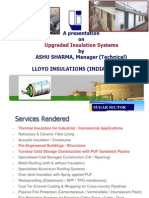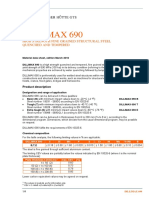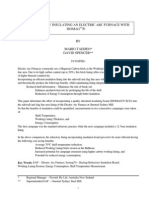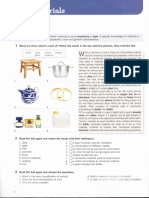Technical Characteristics and Reference Standards: Zintek® in The Building Industry
Technical Characteristics and Reference Standards: Zintek® in The Building Industry
Uploaded by
api-112807037Copyright:
Available Formats
Technical Characteristics and Reference Standards: Zintek® in The Building Industry
Technical Characteristics and Reference Standards: Zintek® in The Building Industry
Uploaded by
api-112807037Original Title
Copyright
Available Formats
Share this document
Did you find this document useful?
Is this content inappropriate?
Copyright:
Available Formats
Technical Characteristics and Reference Standards: Zintek® in The Building Industry
Technical Characteristics and Reference Standards: Zintek® in The Building Industry
Uploaded by
api-112807037Copyright:
Available Formats
TECHNICAL CHARACTERISTICS AND REFERENCE STANDARDS
Zintek is a very high quality zinc-copper-titanium alloy. It fully complies with European standard EN 988 Specifications for zinc and zinc alloy rolled flat products for building. It specifies the requirements for zinc-coppertitanium rolled flat products used in buildings supplied in coils, sheets or strips. According to European norm EN 1179, the alloy is to be produced from 99.995 zinc (Z1 quality) with the addition of appropriate alloying elements. The alloy components enhance the rolled zinc section properties: Titanium increases the resistance to permanent strain over time; Copper increases the material tensile strength. The combination of both reduces the alloy coefficient of expansion.
ZINTEK IN THE BUILDING INDUSTRY
The use of rolled zinc sections in the building industry has a very long tradition which makes it the most popular nonferrous material in Europe for roofing and cladding. With its rolled sections branded zintek, Simar offers an interesting combination of technical and aesthetic performances valuable in functional and economic terms. Zintek is a top material for Environmental cross-compliance. Cost reduction in comparison with non-ferrous metals used in similar applications. No maintenance is needed. Durability over time. Pleasant appearance. Its chemical-physical properties allow for optimum workability and weldability. Resistance to weather corrosion implies no maintenance and restoration costs, and enhances the design of buildings in various contexts. Physical and Mechanical Properties Description Density Melting point Specific heat at 20C Thermal conductivity at 20C Electrical conductivity at 20C Coefficient of thermal expansion lengthwise to lamination Coefficient of thermal expansion transversal to lamination Recrystallization limits Modulus of elasticity Erichsen drawing Length tolerances at 180 20C Width tolerances at 180 20C Camber tolerances Nonmagnetic Fireproof Unit of measurement Kg/dm3 C kJ/kgC W/m K m/ohm mm mm/m C
2
zintek standard: UNI EN 988
a) composition in percentage values Element Cu Ti Al Zn(1) Min. 0,080 0,060 ------resto Max. 1,000 0,200 0,015 resto
Value 7,14 419 0,401 109 17 0,022
(1) Z1 quality Zinc (See table UNI EN 1179)
zintek standard: UNI EN 988
b) mechanical properties 0,2% Unit load yield strength Rp 0,2 N/mm Tensile strength Rm N/mm2 A50mm % %
2
100 min
150 min
mm/m C C N/mm2 mm n n %
0,017 > 300 > 80000 79 3 minimo 5 minimo 40 55
Ultimate percent elongation
35 min
Yield value percent elongation Minimum hardness
0,1 max
HV
45
C. F. - P. I.V.A. - Reg. Imp . 03644560272 - R.E.A. VE 326006 - C. S. euro 100.000,00 i.v. Societ unipersonale soggetta all'attivit di direzione e coordinamento della Simar Societ Metalli Marghera SpA
FEATURES OF SUPPLIED PRODUCTS Mass specifications Nominal thickness Approximate mass mm 0,60 0,65 0,70 0,80 1,00 Kg/m2 4,3 4,7 5,0 5,8 7,2 Plates and strips Plates and strips are cut into perfectly flat sheets and strapped to wooden pallets, protected by waterproof paper on the underside and cardboard on top. Available thickness 0.60 0.65 0.70 0.80 1.00 mm Different thickness sizes can be manufactured upon request. Available widths between 100 mm and 1000 mm items with smaller or larger widths may be manufactured upon request up to a maximum width of 1150 mm. Available lengths Plates come in standard sizes of 1000 X 2000/3000 mm; different sizes plates must be specifically requested. Weight Coil: weight varies according to width. Maximum weight is approximately 7000 kg for mother coils. Sheets: from 500-1.000-1.500-2.000 kg Tolerances Thickness: maximum yield from nominal thickness ordered shall not exceed +/- 0.03. Width Maximum yield from nominal width ordered shall not exceed 0/+2 mm. Minimum nominal width is 100 mm; maximum nominal width is 1000 mm. Length Maximum yield from nominal length of sheet or strip ordered shall not exceed 0/+10 mm. Recommended length values are 2000 mm and 3000 mm. Rectilinear yield Rectilinear yield shall not exceed 1.5 mm/m. Plane yield Plane yield shall not exceed 2 m SURFACE APPEARANCE The natural look of zintek is a rolling-produced grayish colour, consistent and shiny. Atmospheric agents cause the surface to oxidize naturally, creating a protective layer stable over time. This natural ageing process creates a pleasant slightly gray weathered look. The oxidation process may change the surface colour unevenly, creating different gray shades. However, it is only a transitory process ending with a beautiful and uniform colour all over the surface. The natural look can be adjusted through specific surface treatment.
Coils Rolled sections with internal diameter of 508 mm (on cardboard core with or without protective layer), suitably wrapped, are placed on wooden pallets to facilitate movements throughout the handling process
REACTIVITY TO ATMOSPHERIC AGENTS AND CORROSION PROTECTION
The protective layer which is a direct consequence of the exposure of zinc to oxygen and water is a basic zinc carbonate layer which preserves the metal. This process occurs naturally and is the reason for the longevity of zinc.
Environment durability
Environment Rural Urban Industrial Industrial agglomeration Marine
Durability Over 100 years 60 years 40 years 40 to 60 years
REACTIVITY TO TEMPERATURE VARIATIONS Temperature variations have no influence whatsoever over rolled sections after the processing and laying phases. Rolled sections are best processed at temperatures below 10 C (50 F). It is good practice to begin work after having brought the temperature of the rolled sections at the minimum value as specified above. As far as winter projects are concerned, it is advisable to comply with good practices, i.e. to use a workshop for the fabrication of items, as thermal conditions are better inside. For any on-site fabrications, rolled sections may be preheated through hotair ventilation. . Its melting point is approximately 419 C (786 F) and its recrystallization limit, which is very important for the soldering process, equals 300 C (572 F).Fireproof and resistant to ultraviolet light, the material is totally unaffected by wind erosion. ZINTEK INSTALLATION Details for installation can be found in the handbook Development in Architecture. Furthermore, estimated costs and applications are included in the online specifications, available at www.zintek.it.
You might also like
- Dynaflow Lecture Presentation Gaskets 7-10-2010Document125 pagesDynaflow Lecture Presentation Gaskets 7-10-2010Jan Smit100% (1)
- Weld Like a Pro: Beginning to Advanced TechniquesFrom EverandWeld Like a Pro: Beginning to Advanced TechniquesRating: 4.5 out of 5 stars4.5/5 (6)
- E747 97 Wire IQI PDFDocument14 pagesE747 97 Wire IQI PDFAmith100% (1)
- 04 LloydDocument107 pages04 LloydAgung Pramu AjiNo ratings yet
- Topdek Data SheetDocument3 pagesTopdek Data SheetAlfred GandNo ratings yet
- 04 Lloyd Insulation SDocument39 pages04 Lloyd Insulation SBalson VijaishNo ratings yet
- Product Data Sheet: Product: Ks1000 SF EcosafeDocument4 pagesProduct Data Sheet: Product: Ks1000 SF EcosafeSamuel RICEANNo ratings yet
- Mds Rheinzink-Artcolor Skygrey 04 2018 de enDocument3 pagesMds Rheinzink-Artcolor Skygrey 04 2018 de encarlosNo ratings yet
- Locked SeamDocument8 pagesLocked SeamTony DuignanNo ratings yet
- Lexan Polycarbonate 9030 Technical Properties Data SheetDocument6 pagesLexan Polycarbonate 9030 Technical Properties Data Sheetenki95823100% (1)
- KS1000 RW Panel UK Roof Poduct Data SheetDocument6 pagesKS1000 RW Panel UK Roof Poduct Data SheetThe Lone GunmanNo ratings yet
- Flexible Duct Insulated & Non InsulatedDocument4 pagesFlexible Duct Insulated & Non Insulatedali faragallahNo ratings yet
- KS1000 KingzipDocument7 pagesKS1000 KingzipmrajansubramanianNo ratings yet
- Titanium Nitride (Tin) : Physical Vapour Deposition (PVD) Process. The Coating Has High Hardness and LowDocument19 pagesTitanium Nitride (Tin) : Physical Vapour Deposition (PVD) Process. The Coating Has High Hardness and LowhadeNo ratings yet
- Cor-Ten - Weather & Corrosion Resistant SteelDocument5 pagesCor-Ten - Weather & Corrosion Resistant SteelAnjan DeyNo ratings yet
- Lysaght OptimaDocument8 pagesLysaght OptimaAgung PriambodhoNo ratings yet
- LloydDocument125 pagesLloydpartha070No ratings yet
- Kingspan PIR Datasheet King Zip Roof July 2020Document10 pagesKingspan PIR Datasheet King Zip Roof July 2020Georgios PNo ratings yet
- KS1000 RW Roof Panel Product DataDocument4 pagesKS1000 RW Roof Panel Product DataIvanSmithNo ratings yet
- Sheetpile Catalogue NipponDocument20 pagesSheetpile Catalogue NipponTony Lai100% (1)
- Acousteel Brochure Digital FINALDocument8 pagesAcousteel Brochure Digital FINALfahadullahNo ratings yet
- Kaiflex MasterSpecificationDocument8 pagesKaiflex MasterSpecificationnaseema1No ratings yet
- Trimo Introduces Itself: DetailsDocument290 pagesTrimo Introduces Itself: DetailsinstorkNo ratings yet
- Clip LockDocument16 pagesClip LockctaciutNo ratings yet
- MDS RHEINZINK-prePATINA Blue-Grey 11 - 2015 - DE - enDocument4 pagesMDS RHEINZINK-prePATINA Blue-Grey 11 - 2015 - DE - enPetre Cristian AlexandruNo ratings yet
- Fireproof ROOF Panels Trimoterm SNV: Technical InformationDocument4 pagesFireproof ROOF Panels Trimoterm SNV: Technical InformationAdi ApoNo ratings yet
- FRS Electrical Panel Spec EOIDocument20 pagesFRS Electrical Panel Spec EOITravis WoodNo ratings yet
- John Chan - Sun AceDocument24 pagesJohn Chan - Sun AceDario MendezNo ratings yet
- Rubber Mastic and Sealant Tapes PDFDocument18 pagesRubber Mastic and Sealant Tapes PDFNikhil MathewNo ratings yet
- Stramit Monoclad: Product Technical ManualDocument8 pagesStramit Monoclad: Product Technical Manualchillerz69No ratings yet
- R1BOQ - Structural - 13.03.2021Document24 pagesR1BOQ - Structural - 13.03.2021prasanth parthasarathyNo ratings yet
- Atcoatr 111Document3 pagesAtcoatr 111farid bashaNo ratings yet
- PB Alumec EnglishDocument12 pagesPB Alumec EnglishByron RodriguezNo ratings yet
- Dillimax 690: High Strength Fine Grained Structural Steel Quenched and TemperedDocument4 pagesDillimax 690: High Strength Fine Grained Structural Steel Quenched and TemperedBui Chi TamNo ratings yet
- Superlon 16 Pages CatalogDocument16 pagesSuperlon 16 Pages CatalogDevan SanmugamNo ratings yet
- Dillimax 690 eDocument4 pagesDillimax 690 ePrabhakar TiwariNo ratings yet
- Roof and Wall LeafletDocument6 pagesRoof and Wall LeafletcosineNo ratings yet
- 2012 Lecture BKC Insulations & RefractoryDocument30 pages2012 Lecture BKC Insulations & Refractorydeb_bratapalNo ratings yet
- Sirius 314: A 25% CR - 1.8 % Si Heat Resistant Stainless SteelDocument4 pagesSirius 314: A 25% CR - 1.8 % Si Heat Resistant Stainless SteelVíctor SandovskyNo ratings yet
- Thermal Expansion CalcsDocument6 pagesThermal Expansion CalcsGokulnath TgNo ratings yet
- Panelex DataDocument1 pagePanelex DataTimothy GordonNo ratings yet
- Kohinoor Square Facade Know HowDocument14 pagesKohinoor Square Facade Know HowVinay SrivastavaNo ratings yet
- KS1200 AB Product Data NordicDocument4 pagesKS1200 AB Product Data NordicDirt FilterNo ratings yet
- Revised MS For WaterproofingDocument9 pagesRevised MS For WaterproofingChamux skalNo ratings yet
- 9-EAFTechnical PaperV1Document15 pages9-EAFTechnical PaperV1chandirandelhiNo ratings yet
- RO3000 Pour Rogers 3006 PDFDocument4 pagesRO3000 Pour Rogers 3006 PDFTeddy112No ratings yet
- Insulation and RefractoriesDocument42 pagesInsulation and RefractoriesGH Eco RJNo ratings yet
- Isofire Roof 1000 PDFDocument2 pagesIsofire Roof 1000 PDFIon VasileNo ratings yet
- Isofire Wall-1000 PDFDocument2 pagesIsofire Wall-1000 PDFliviu_dovaNo ratings yet
- TDS Siltherm-AluFlex 05-2022Document2 pagesTDS Siltherm-AluFlex 05-2022benjaminNo ratings yet
- Thermal InsulationDocument2 pagesThermal InsulationPrabhat DhekaleNo ratings yet
- Hvac Duct Insulation SpecificationDocument2 pagesHvac Duct Insulation SpecificationPrabhat DhekaleNo ratings yet
- 1.4845 EnglDocument3 pages1.4845 EnglpdmsNo ratings yet
- KS1000 SS Single Skin Product Data - 2016 RG PDFDocument2 pagesKS1000 SS Single Skin Product Data - 2016 RG PDFTomek Buda100% (1)
- Compendium of Atomic Alkali Resistant Optical Thin Films, Diffusion and Electrical Mobility in Diode Pumped Alkali Lasers (DPALs)From EverandCompendium of Atomic Alkali Resistant Optical Thin Films, Diffusion and Electrical Mobility in Diode Pumped Alkali Lasers (DPALs)No ratings yet
- Ceramic Materials for Energy Applications VIFrom EverandCeramic Materials for Energy Applications VIHua-Tay LinNo ratings yet
- A Practical Workshop Companion for Tin, Sheet Iron, and Copper Plate Workers: Containing Rules for Describing Various Kinds of Patterns used by Tin, Sheet Iron, and Copper Plate Workers, Practical Geometry, Mensuration of Surfaces and Solids, Tables of the Weights of Metals, Lead Pipe, Tables of Areas and CircumferencesFrom EverandA Practical Workshop Companion for Tin, Sheet Iron, and Copper Plate Workers: Containing Rules for Describing Various Kinds of Patterns used by Tin, Sheet Iron, and Copper Plate Workers, Practical Geometry, Mensuration of Surfaces and Solids, Tables of the Weights of Metals, Lead Pipe, Tables of Areas and CircumferencesNo ratings yet
- Astm A-297 HPDocument2 pagesAstm A-297 HPeduardo_exsys100% (1)
- Part-B Sub-Section - Iiib-08 TransformerDocument24 pagesPart-B Sub-Section - Iiib-08 TransformerPhanidev Kumar50% (2)
- NHT-P51-00032 04MDocument937 pagesNHT-P51-00032 04MnmosilvaNo ratings yet
- Chem - First Sem-I - PraticalDocument27 pagesChem - First Sem-I - PraticalsureshNo ratings yet
- M Kumar Ci (Em) /Irimee/JmpDocument51 pagesM Kumar Ci (Em) /Irimee/JmpSaptarshi PalNo ratings yet
- Presentation Casting DefectDocument94 pagesPresentation Casting Defecttanydhillon100% (1)
- Effects of Alloying Elements in SteelDocument3 pagesEffects of Alloying Elements in SteelSanthosh Kumar VempatiNo ratings yet
- E7018Document2 pagesE7018sajay2010No ratings yet
- A148 14Document4 pagesA148 14عصام السامرائيNo ratings yet
- MildsteelDocument2 pagesMildsteelMacedo S OliveiraNo ratings yet
- M7 ZR PDFDocument2 pagesM7 ZR PDFjunaid112No ratings yet
- WJ 1973 10 s433 PDFDocument8 pagesWJ 1973 10 s433 PDFAditya PrajasNo ratings yet
- Pressure Die PPT InPDFDocument41 pagesPressure Die PPT InPDFSree RamichettyNo ratings yet
- Air Coolers LiteratureDocument11 pagesAir Coolers Literatureyinkaakins200150% (4)
- Classification Exercises Materials PDFDocument6 pagesClassification Exercises Materials PDFmatina14100% (1)
- Astm A959-11 PDFDocument8 pagesAstm A959-11 PDFRavichandran DNo ratings yet
- MigatronicDocument40 pagesMigatronicRogo CatalinNo ratings yet
- Nordent Catalog Restorative PagesDocument25 pagesNordent Catalog Restorative PagesMuhammad Shoaib JavedNo ratings yet
- T - Thermanit 304 H Cu - Gtaw - 01 - 01 - en PDFDocument1 pageT - Thermanit 304 H Cu - Gtaw - 01 - 01 - en PDFnebojsa70No ratings yet
- Havells Commercial LightingDocument38 pagesHavells Commercial LightingRavi SankerNo ratings yet
- Mind MapDocument13 pagesMind MapRahimah Na'ain100% (1)
- HSA Stud AnchorDocument11 pagesHSA Stud AnchorWin ThanNo ratings yet
- Detail C: 50 (Dowel)Document1 pageDetail C: 50 (Dowel)ahmedNo ratings yet
- Spiral MixerDocument2 pagesSpiral MixerAmândio PintoNo ratings yet
- AstmDocument4 pagesAstmedisjdavNo ratings yet
- Commander 1000 5PT10 Davit Crane Product Sheet - PS5PT10-A-0221Document7 pagesCommander 1000 5PT10 Davit Crane Product Sheet - PS5PT10-A-0221DiljithNo ratings yet
- SEP - 1390e 1996 07Document3 pagesSEP - 1390e 1996 07Vijayakumar SamyNo ratings yet
- IbsDocument26 pagesIbsAshadi HamdanNo ratings yet
- Annex 1 CCM ProcessDocument16 pagesAnnex 1 CCM ProcessehsanNo ratings yet

























































































